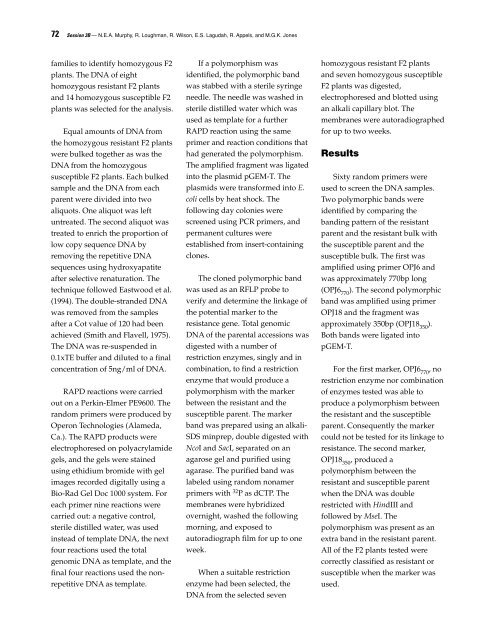Septoria and Stagonospora Diseases of Cereals - CIMMYT ...
Septoria and Stagonospora Diseases of Cereals - CIMMYT ...
Septoria and Stagonospora Diseases of Cereals - CIMMYT ...
You also want an ePaper? Increase the reach of your titles
YUMPU automatically turns print PDFs into web optimized ePapers that Google loves.
72<br />
Session 3B — N.E.A. Murphy, R. Loughman, R. Wilson, E.S. Lagudah, R. Appels, <strong>and</strong> M.G.K. Jones<br />
families to identify homozygous F2<br />
plants. The DNA <strong>of</strong> eight<br />
homozygous resistant F2 plants<br />
<strong>and</strong> 14 homozygous susceptible F2<br />
plants was selected for the analysis.<br />
Equal amounts <strong>of</strong> DNA from<br />
the homozygous resistant F2 plants<br />
were bulked together as was the<br />
DNA from the homozygous<br />
susceptible F2 plants. Each bulked<br />
sample <strong>and</strong> the DNA from each<br />
parent were divided into two<br />
aliquots. One aliquot was left<br />
untreated. The second aliquot was<br />
treated to enrich the proportion <strong>of</strong><br />
low copy sequence DNA by<br />
removing the repetitive DNA<br />
sequences using hydroxyapatite<br />
after selective renaturation. The<br />
technique followed Eastwood et al.<br />
(1994). The double-str<strong>and</strong>ed DNA<br />
was removed from the samples<br />
after a Cot value <strong>of</strong> 120 had been<br />
achieved (Smith <strong>and</strong> Flavell, 1975).<br />
The DNA was re-suspended in<br />
0.1xTE buffer <strong>and</strong> diluted to a final<br />
concentration <strong>of</strong> 5ng/ml <strong>of</strong> DNA.<br />
RAPD reactions were carried<br />
out on a Perkin-Elmer PE9600. The<br />
r<strong>and</strong>om primers were produced by<br />
Operon Technologies (Alameda,<br />
Ca.). The RAPD products were<br />
electrophoresed on polyacrylamide<br />
gels, <strong>and</strong> the gels were stained<br />
using ethidium bromide with gel<br />
images recorded digitally using a<br />
Bio-Rad Gel Doc 1000 system. For<br />
each primer nine reactions were<br />
carried out: a negative control,<br />
sterile distilled water, was used<br />
instead <strong>of</strong> template DNA, the next<br />
four reactions used the total<br />
genomic DNA as template, <strong>and</strong> the<br />
final four reactions used the nonrepetitive<br />
DNA as template.<br />
If a polymorphism was<br />
identified, the polymorphic b<strong>and</strong><br />
was stabbed with a sterile syringe<br />
needle. The needle was washed in<br />
sterile distilled water which was<br />
used as template for a further<br />
RAPD reaction using the same<br />
primer <strong>and</strong> reaction conditions that<br />
had generated the polymorphism.<br />
The amplified fragment was ligated<br />
into the plasmid pGEM-T. The<br />
plasmids were transformed into E.<br />
coli cells by heat shock. The<br />
following day colonies were<br />
screened using PCR primers, <strong>and</strong><br />
permanent cultures were<br />
established from insert-containing<br />
clones.<br />
The cloned polymorphic b<strong>and</strong><br />
was used as an RFLP probe to<br />
verify <strong>and</strong> determine the linkage <strong>of</strong><br />
the potential marker to the<br />
resistance gene. Total genomic<br />
DNA <strong>of</strong> the parental accessions was<br />
digested with a number <strong>of</strong><br />
restriction enzymes, singly <strong>and</strong> in<br />
combination, to find a restriction<br />
enzyme that would produce a<br />
polymorphism with the marker<br />
between the resistant <strong>and</strong> the<br />
susceptible parent. The marker<br />
b<strong>and</strong> was prepared using an alkali-<br />
SDS minprep, double digested with<br />
NcoI <strong>and</strong> SacI, separated on an<br />
agarose gel <strong>and</strong> purified using<br />
agarase. The purified b<strong>and</strong> was<br />
labeled using r<strong>and</strong>om nonamer<br />
primers with 32P as dCTP. The<br />
membranes were hybridized<br />
overnight, washed the following<br />
morning, <strong>and</strong> exposed to<br />
autoradiograph film for up to one<br />
week.<br />
When a suitable restriction<br />
enzyme had been selected, the<br />
DNA from the selected seven<br />
homozygous resistant F2 plants<br />
<strong>and</strong> seven homozygous susceptible<br />
F2 plants was digested,<br />
electrophoresed <strong>and</strong> blotted using<br />
an alkali capillary blot. The<br />
membranes were autoradiographed<br />
for up to two weeks.<br />
Results<br />
Sixty r<strong>and</strong>om primers were<br />
used to screen the DNA samples.<br />
Two polymorphic b<strong>and</strong>s were<br />
identified by comparing the<br />
b<strong>and</strong>ing pattern <strong>of</strong> the resistant<br />
parent <strong>and</strong> the resistant bulk with<br />
the susceptible parent <strong>and</strong> the<br />
susceptible bulk. The first was<br />
amplified using primer OPJ6 <strong>and</strong><br />
was approximately 770bp long<br />
(OPJ6770 ). The second polymorphic<br />
b<strong>and</strong> was amplified using primer<br />
OPJ18 <strong>and</strong> the fragment was<br />
approximately 350bp (OPJ18350 ).<br />
Both b<strong>and</strong>s were ligated into<br />
pGEM-T.<br />
For the first marker, OPJ6770 , no<br />
restriction enzyme nor combination<br />
<strong>of</strong> enzymes tested was able to<br />
produce a polymorphism between<br />
the resistant <strong>and</strong> the susceptible<br />
parent. Consequently the marker<br />
could not be tested for its linkage to<br />
resistance. The second marker,<br />
OPJ18350 , produced a<br />
polymorphism between the<br />
resistant <strong>and</strong> susceptible parent<br />
when the DNA was double<br />
restricted with HindIII <strong>and</strong><br />
followed by MseI. The<br />
polymorphism was present as an<br />
extra b<strong>and</strong> in the resistant parent.<br />
All <strong>of</strong> the F2 plants tested were<br />
correctly classified as resistant or<br />
susceptible when the marker was<br />
used.









